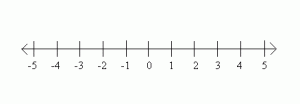In the last post, I mentioned that I describe my job as teaching people how to count to one. This was well-received by some, though I suspect more don’t quite get its significance.
Counting, just counting, is easy. (Kinda.)
 We are familiar with the basic number line. Going from 0 to 1 is easy, right? We just move one space. But what does that mean?
We are familiar with the basic number line. Going from 0 to 1 is easy, right? We just move one space. But what does that mean?
“Tod, how many students do we have here?”
“11,729.”
“Really? That seems low. I thought I heard the president give a larger number.”
“Well, we have 323 students in study abroad programs in Spain.”
“Okay, that’s better, but Iwas thinking the total was around 15,000.”
“Yes, if you include the students at the off-campus sites, the total enrollment is 15,892.”
“Right! Why didn’t you tell me that before?’
“You asked how many students we have here.”
“Oh. So, are these headcount or FTE?”
And so it goes.
But even more importantly, before we could even get to the first number, we were operating under the assumption that we both have the same definition of “student.” That was never verified in the exchange above, but let’s assume that it is true. That the inquisitor and I knew we both meant that a student was an individual with a specific kind of relationship to the institution. In fact, we knew that “student” is really a general term for a class of groups of individuals with similar, but differing relationships to the institution. These differences may be the level of the degree sought, whether or not they are even seeking a degree, if tuition is paid, if so, under what policies, and so on.
Getting to one requires definition. And as Jeff points out, making choices about who, what, and how someone or something is counted is fraught with peril.
How much fruit do we have?
About seven pounds.
No, no, no, how many pieces?
Gee, that depends on how you cut it.
Dammit, Tod! You know what I mean!
Okay,eight plus 100-150.
What?!
Look, there is a big bag of grapes, I’m not going to count them. There are also two bananas, three apples, an orange, and two tomatoes.
The distance between 1 and 2 is easy, as it is between 2 and 3, and so on. But it is only easy because we have done the hard work of defining the distance between 0 and 1.

Pingback: A simple devolutionary what if | random data from a tumored head
Pingback: On Counting to One | Data Not Shown (of the Dead)
Pingback: How data does political things: The processes of encoding and decoding data are never neutral | Data Not Shown (of the Dead)
Pingback: Redefinition, the 4th | random data from a tumored head
Pingback: yes, data can lie | random data from a tumored head
Pingback: Counting and Measuring | random data from a tumored head
Pingback: thoughts from a conference | random data from a tumored head
Pingback: Against the Economic Pie: How Economic “Maximizing” Skews Legal Analysis « Law and Political Economy
Pingback: Against the Economic Pie: How Economic “Maximizing” Skews Legal Analysis - LPE Project